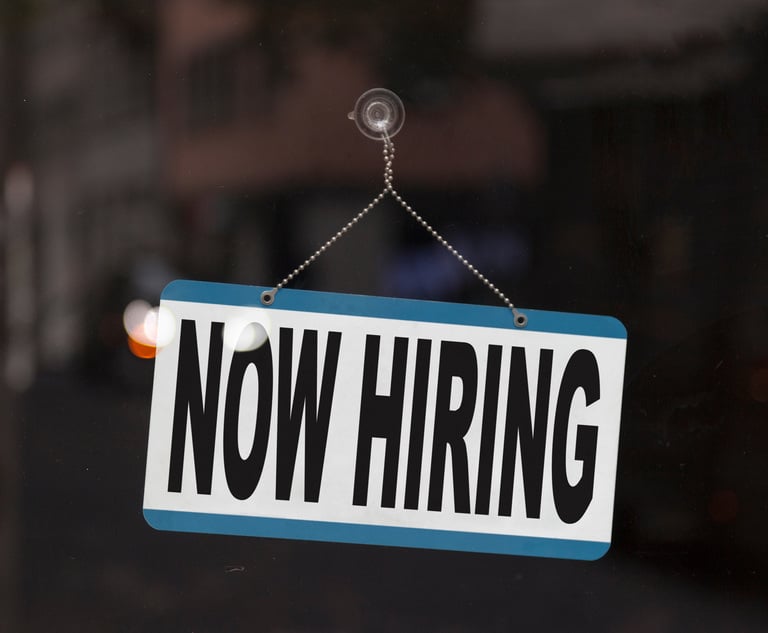 (Photo: Bruce Shaw/Administrative Office of the Courts)
(Photo: Bruce Shaw/Administrative Office of the Courts)Justice Building Topped Out at Last
Georgia's appellate court judges and justices set aside their robes for hard hats, goggles, vests and markers and gathered to sign the final beam to top their new home.
November 27, 2018 at 05:58 PM
3 minute read
The wind was cold but the sun was bright as the justices of the Georgia Supreme Court and the judges of the Georgia Court of Appeals signed the final beam to top the $127 million building that will be home to the state's high and intermediate appellate courts.
“I can't believe this is happening. I have to pinch myself,” said the lead architect on the job, Bill Clark, president of the Atlanta office of Stevens & Wilkinson. “We've been talking about this for 20 years.”
Clark guessed that maybe Roy Barnes was governor of Georgia when his firm first began the dream stages of designing a dedicated home for the state's appellate courts. It could have been Zell Miller, he added.
But it was Gov. Nathan Deal who at last signed legislation to put the dream down on paper and find the money to pay for it.
Clark has worked on other iconic Atlanta construction projects: Hartsfield-Jackson International Airport and Central Library in downtown Atlanta. The latter has become one of the country's most famous examples of Brutalist architecture. But for the judicial building, the state's leaders wanted a more traditional design, one that would blend in with other state offices and the Capitol, whose gold dome comes clearly into view from the construction site on Memorial Drive.
Clark's architectural firm and the general contractor, Gilbane, shared a private lunch with the judges and justices in the heated quarters of the biggest in a small village of construction trailers on the site. Afterward, the judges and justices strolled out wearing hard hats, goggles and yellow-and-orange vests. They gathered around that last beam—topped with a tiny evergreen tree, as building tradition dictates for luck, and the Georgia and U.S. flags. They signed their names with extra fat Sharpie markers. Then they climbed into open air construction elevators and rode up the side of the building to take a private tour.
The bulk of the financing came from $105 million worth of bonds sold in 2017, according to Building Authority Executive Director Steve Stancil. The total price tag for the project is up to about $127 million, according to the latest figures from the building authority chief financial officer, shared by Morgan Smith-Williams, public relations coordinator for the State Properties Commission and Building Authority. So far, about $119 million has been appropriated for construction, design and site preparation. That includes demolition and cleanup from the state archives building that was on the site. Plus, at the moment, the Georgia Building Authority has $8.5 million set aside for furniture, fixtures and equipment related to the building.
The topping-out event had been delayed by the death of retired Chief Justice P. Harris Hines, who had helped plan the building. His colleagues mourned him, as they said, with heavy hearts. Then the event was delayed again by rain.
But on Tuesday the clouds cleared, and the mood lifted. Chief Justice Harold Melton chose to forgo the expected ceremonial remarks. But he did add one more signature to the beam: P. Harris Hines. As the high court's public information officer Jane Hansen said, “He was there in spirit.”
This content has been archived. It is available through our partners, LexisNexis® and Bloomberg Law.
To view this content, please continue to their sites.
Not a Lexis Subscriber?
Subscribe Now
Not a Bloomberg Law Subscriber?
Subscribe Now
NOT FOR REPRINT
© 2025 ALM Global, LLC, All Rights Reserved. Request academic re-use from www.copyright.com. All other uses, submit a request to [email protected]. For more information visit Asset & Logo Licensing.
You Might Like
View All
Sanctions Order Over Toyota's Failure to Provide English Translations of Documents Vacated by Appeals Court
4 minute read
Burr & Forman, Smith Gambrell & Russell Promote More to Partner This Year
7 minute read
Trending Stories
- 1Restoring Trust in the Courts Starts in New York
- 2'Pull Back the Curtain': Ex-NFL Players Seek Discovery in Lawsuit Over League's Disability Plan
- 3Tensions Run High at Final Hearing Before Manhattan Congestion Pricing Takes Effect
- 4Improper Removal to Fed. Court Leads to $100K Bill for Blue Cross Blue Shield
- 5Michael Halpern, Beloved Key West Attorney, Dies at 72
Who Got The Work
Michael G. Bongiorno, Andrew Scott Dulberg and Elizabeth E. Driscoll from Wilmer Cutler Pickering Hale and Dorr have stepped in to represent Symbotic Inc., an A.I.-enabled technology platform that focuses on increasing supply chain efficiency, and other defendants in a pending shareholder derivative lawsuit. The case, filed Oct. 2 in Massachusetts District Court by the Brown Law Firm on behalf of Stephen Austen, accuses certain officers and directors of misleading investors in regard to Symbotic's potential for margin growth by failing to disclose that the company was not equipped to timely deploy its systems or manage expenses through project delays. The case, assigned to U.S. District Judge Nathaniel M. Gorton, is 1:24-cv-12522, Austen v. Cohen et al.
Who Got The Work
Edmund Polubinski and Marie Killmond of Davis Polk & Wardwell have entered appearances for data platform software development company MongoDB and other defendants in a pending shareholder derivative lawsuit. The action, filed Oct. 7 in New York Southern District Court by the Brown Law Firm, accuses the company's directors and/or officers of falsely expressing confidence in the company’s restructuring of its sales incentive plan and downplaying the severity of decreases in its upfront commitments. The case is 1:24-cv-07594, Roy v. Ittycheria et al.
Who Got The Work
Amy O. Bruchs and Kurt F. Ellison of Michael Best & Friedrich have entered appearances for Epic Systems Corp. in a pending employment discrimination lawsuit. The suit was filed Sept. 7 in Wisconsin Western District Court by Levine Eisberner LLC and Siri & Glimstad on behalf of a project manager who claims that he was wrongfully terminated after applying for a religious exemption to the defendant's COVID-19 vaccine mandate. The case, assigned to U.S. Magistrate Judge Anita Marie Boor, is 3:24-cv-00630, Secker, Nathan v. Epic Systems Corporation.
Who Got The Work
David X. Sullivan, Thomas J. Finn and Gregory A. Hall from McCarter & English have entered appearances for Sunrun Installation Services in a pending civil rights lawsuit. The complaint was filed Sept. 4 in Connecticut District Court by attorney Robert M. Berke on behalf of former employee George Edward Steins, who was arrested and charged with employing an unregistered home improvement salesperson. The complaint alleges that had Sunrun informed the Connecticut Department of Consumer Protection that the plaintiff's employment had ended in 2017 and that he no longer held Sunrun's home improvement contractor license, he would not have been hit with charges, which were dismissed in May 2024. The case, assigned to U.S. District Judge Jeffrey A. Meyer, is 3:24-cv-01423, Steins v. Sunrun, Inc. et al.
Who Got The Work
Greenberg Traurig shareholder Joshua L. Raskin has entered an appearance for boohoo.com UK Ltd. in a pending patent infringement lawsuit. The suit, filed Sept. 3 in Texas Eastern District Court by Rozier Hardt McDonough on behalf of Alto Dynamics, asserts five patents related to an online shopping platform. The case, assigned to U.S. District Judge Rodney Gilstrap, is 2:24-cv-00719, Alto Dynamics, LLC v. boohoo.com UK Limited.
Featured Firms
Law Offices of Gary Martin Hays & Associates, P.C.
(470) 294-1674
Law Offices of Mark E. Salomone
(857) 444-6468
Smith & Hassler
(713) 739-1250







